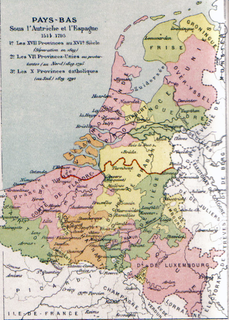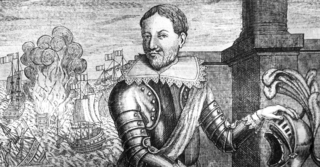Related Research Articles

Maarten Harpertszoon Tromp was a Dutch army general and admiral in the Dutch navy.

Dunkirk is a commune in Nord, a French department in northern France. It lies 10 kilometres (6.2 mi) from the Belgian border. It has the third-largest French harbour. The population of the commune at the 2016 census was 91,412.

The Southern Netherlands, also called the Catholic Netherlands, was the part of the Low Countries largely controlled by Spain (1556–1714), later Austria (1714–1794), and occupied by France (1794–1815). The region also included a number of smaller states that were never ruled by Spain or Austria: the Prince-Bishopric of Liège, the Imperial Abbey of Stavelot-Malmedy, the County of Bouillon, the County of Horne and the Princely Abbey of Thorn. The Southern Netherlands were part of the Holy Roman Empire until the whole area was annexed by Revolutionary France.

The Anglo-Spanish War was a conflict between the English Protectorate under Oliver Cromwell and Spain, between 1654 and 1660. It was caused by commercial rivalry. Each side attacked the other's commercial and colonial interests in various ways such as privateering and naval expeditions. In 1655, an English amphibious expedition invaded Spanish territory in the Caribbean. In 1657, England formed an alliance with France, merging the Anglo–Spanish war with the larger Franco-Spanish War resulting in major land actions that took place in the Spanish Netherlands.

The Battle of the Downs took place on 21 October 1639, during the Eighty Years' War. A Spanish fleet, commanded by Admiral Antonio de Oquendo, was decisively defeated by a Dutch force under Lieutenant-Admiral Maarten Tromp. Victory ended Spanish efforts to re-assert naval control over the English Channel and confirmed Dutch dominance of the sea lanes, while it is also alleged to be the first major action to feature line of battle tactics.

The Anglo-Spanish War (1585–1604) was an intermittent conflict between the kingdoms of Spain and England that was never formally declared. The war was punctuated by widely separated battles, and began with England's military expedition in 1585 to what was then the Spanish Netherlands under the command of Robert Dudley, Earl of Leicester, in support of the resistance of the States General to Spanish Habsburg rule.

The Battle of Getaria was fought on 22 August 1638 during the Franco-Spanish War (1635–59), at Getaria, in northern Spain. A French naval force commanded by Henri de Sourdis attacked and destroyed a Spanish squadron under Lope de Hoces, who survived but was killed at the Battle of the Downs in 1639.

The Spanish Armada was a Habsburg Spanish fleet of 130 ships that sailed from Lisbon in late May 1588 under the command of the Duke of Medina Sidonia, with the purpose of escorting an army from Flanders to invade England. Medina Sidonia was an aristocrat without naval command experience but was made commander by King Philip II. The aim was to overthrow Queen Elizabeth I and her establishment of Protestantism in England, to stop English interference in the Spanish Netherlands, and to stop the harm caused by English and Dutch privateering ships that disrupted Spanish interests in the Americas.

The Franco-Spanish War (1635–1659) was a military conflict fought by France and Spain, with other powers participating at different points. The first phase which began in 1635 and ended with the 1648 Peace of Westphalia is considered a related conflict of the Thirty Years' War. The second phase continued until 1659 when France and Spain agreed the Treaty of the Pyrenees; most historians view its results as largely inconclusive.

Jacob Collaart or Collaert was a Flemish admiral who served as privateer and one of the Dunkirkers in Spanish Habsburg service during the Dutch Revolt.

Antonio de Oquendo y Zandategui was a Spanish admiral; in 1639 he was in command of the Spanish forces at the Battle of the Downs.

During the Dutch Revolt (1568–1648), the Dunkirkers or Dunkirk Privateers were commerce raiders in the service of the Spanish monarchy. They were also part of the Dunkirk fleet, which consequently was a part of the Spanish monarchy's Flemish fleet(Armada de Flandes). The Dunkirkers operated from the ports of the Flemish coast: Nieuwpoort, Ostend, and Dunkirk. Throughout the Eighty Years' War, the fleet of the Dutch Republic repeatedly tried to destroy the Dunkirkers. The first Dunkirkers sailed a group of warships outfitted by the Spanish government, but non-government investment in privateering soon led to a more numerous fleet of privately owned and outfitted warships.

Jan Jacobsen was a Flemish naval commander and Dunkirker during the Eighty Years' War. He became a posthumous hero when, after battling an enemy fleet for over 13 hours, he destroyed his own ship rather than surrender.

The Dutch Revolt (1566–1648) was the revolt in the Low Countries against the rule of the Habsburg King Philip II of Spain, hereditary ruler of the provinces. The northern provinces eventually separated from the southern provinces, which continued under Habsburg Spain until 1714. The northern provinces adopted Calvinism and Republicanism whereas the southern provinces became wholly Catholic again due to the expulsion of Protestants and the efforts of the Counter-Reformation and remained under absolutist rule. The Dutch Revolt has been viewed as the seedbed of the great democratic revolutions from England, to America to France.

The Army of Flanders was a multinational army in the service of the kings of Spain that was based in the Spanish Netherlands during the 16th to 18th centuries. It was notable for being the longest-serving standing army of the period, being in continuous service from 1567 until its disestablishment in 1706. In addition to taking part in numerous battles of the Dutch Revolt (1567–1609) and the Thirty Years' War (1618–1648), it also employed many developing military concepts more reminiscent of later military units, enjoying permanent, standing regiments (tercios), barracks, military hospitals and rest homes long before they were adopted in most of Europe. Sustained at huge cost and at significant distances from Spain, the Army of Flanders also became infamous for successive mutinies and its ill-disciplined activity off the battlefield, including the Sack of Antwerp in 1576.

The Battle off Lizard Point was a naval action which took place on 18 February 1637 off the coast of Cornwall, England, during the Eighty Years' War. The Spanish admiral Miguel de Horna, commander of the Armada of Flanders, intercepted an important Anglo-Dutch merchant convoy of 44 vessels escorted by six warships, destroying or capturing 20 of them, and returned safely to his base in Dunkirk.

The Battle of Orbetello, also known as the Battle of Isola del Giglio, was a major naval engagement of the Franco-Spanish War of 1635. It was fought on 14 June 1646 off the Spanish-ruled town of Orbetello, on the coast of Tuscany, Italy, between a French fleet led by Admiral Armand de Maillé, Marquis of Brézé, and a Spanish fleet commanded by Miguel de Noronha, 4th Count of Linhares sent to break the blockade of Orbetello and relieve the town, besieged since 12 May by a French army under the command of Prince Thomas of Savoy. The Battle of Orbetello was tactically very unusual, since it was fought by sailing ships towed by galleys in a light breeze.

The action of 18 February 1639 was a naval battle of the Eighty Years' War fought off Dunkirk between a Dutch fleet under the command of Admiral Maarten Tromp and the Spanish Dunkirk Squadron under Miguel de Horna. Horna, who had orders to join with his ships Admiral Antonio de Oquendo's fleet at A Coruña, escorted at the same time a transport convoy carrying 2,000 Walloon soldiers to Spain, where they were needed. The attempt to exit Dunkirk was done in sight of the Dutch blockading squadron of Maarten Tromp. A 4-hour battle ensued and Horna was forced to retreat into Dunkirk leaving behind two of his galleons, whilst another ran aground. Despite his success in stopping the sortie, many of Tromp's ships suffered heavy damage, and the Dutch Admiral was forced to abandon the blockade. Therefore, De Horna, after repairing his squadron, was able to accomplish his mission.

The siege of Sluis of 1587 took place between 12 June and 4 August 1587, as part of the Eighty Years' War and the Anglo-Spanish War (1585–1604). Its capture by the Spanish formed a significant advance towards the Enterprise of England.

The Battle of the Narrow Seas, also known as the Battle of the Goodwin Sands or Battle of the Dover Straits was a naval engagement that took place on 3–4 October 1602 during the Anglo-Spanish War of 1585 and part of the Dutch Revolt. An English fleet under Sir Robert Mansell intercepted and attacked six Spanish galleys under the command of Federico Spinola in the Dover Straits and was fought from off the coast of England and finally off the Spanish Netherlands. The English were soon joined by a Dutch fleet under Jan Adriaanszoon Cant and they completed the destruction.
References
- ↑ Stradling 1992, p. 88.